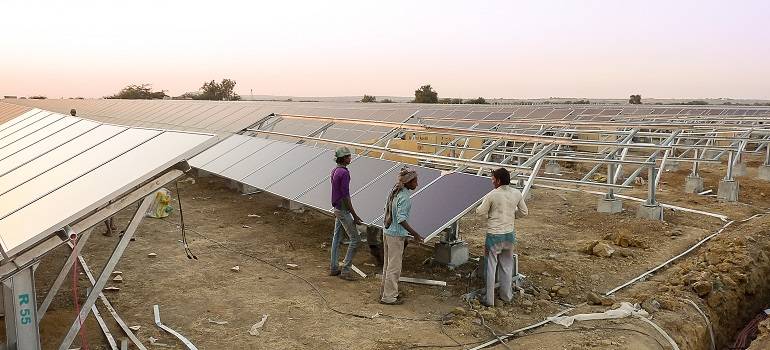
The country’s total solar power generation capacity, including 3.85 gigawatt (GW) rooftops, stood at 28.05 GW while 17.65 GW was under implementation as on December 31, 2018, according to a report by Bridge To India (BTI).
The quarterly market report, titled ‘India Solar Compass Q4 2018’, gives a detailed analysis of capacity addition, tender issuance, market players, price trends for the past quarter and the whole year 2018.
India’s total solar installed capacity and pipeline stood at 28,057 MW and 17,658 MW as on December 31, 2018, according to the report. This capacity is split between utility scale and rooftop solar as 24,202 MW and 3,855 MW, respectively.
It said only 1,446 MW capacity was added in the October-December 2018 period, 990 MW in utility scale solar and 456 MW in rooftop solar.
The utility scale solar capacity addition has been sluggish since the second quarter ended June 30, 2018, and is down 46 per cent over the fourth quarter of 2017. In contrast, the rooftop solar market is growing strongly and is up 47 per cent over previous year, it said.
In the December 2018 quarter, the highest capacity (200 MW) was added in Andhra Pradesh and Gujarat.
Karnataka (5,328 MW), Telangana (3,501 MW) and Rajasthan (3,081 MW) continued to be the top-three states by commissioned capacity for utility scale solar. In 2018, Adani (740 MW), Acme (720 MW) and Essel Infra (460 MW) were the top-three developers by commissioned capacity. GCL, Risen Energy and JA Solar (all Chinese suppliers) were the leading module suppliers, while Sungrow, ABB and Huawei were the leading inverter suppliers.
The EPC (engineering, procurement and construction) market was led by Sterling & Wilson and Mahindra Susten. Module prices have fallen to USD 0.20 per watt, down 44 per cent over the previous year. But, most of this fall has been offset by 25 per cent safeguard duty and 5 per cent GST as well as more than 10 per cent rupee depreciation. Moreover, prices are expected to harden in 2019 by 5 to 10 per cent, it added.
An unprecedented 51,118 MW of new tenders were issued in 2018, with 15 GW tenders in December 2018 quarter alone. However, tender design has not met market expectations — 16,725 MW of tenders were cancelled in 2018 and another 9,238 MW of tenders were undersubscribed, the report stated.
Commenting on the report, Vinay Rustagi, managing director, BTI, said in a statement: “2018 was an extremely testing year for the solar market. Pretty much everything that could go wrong, did go wrong. Issues such as safeguard duty and GST created uncertainty for the entire industry, costs went up, execution challenges mounted and to make matter worse, discoms cancelled many tenders because of unrealistic tariff expectations.”
“2019 is expected to be better but the new government will have to work hard to re-build investor appetite. Rooftop solar remains a bright spot but even this market has seen some serious policy reversals in the last few months,” he added
Source: PTI
MORE TO READ:
SECI inviting bids for setting up of 1200 MW ISTS-connected wind power projects
Solar developers heave a sigh of relief after Maharashtra power regulator’s order
Argentina becomes 72nd country to join International Solar Alliance (ISA)

